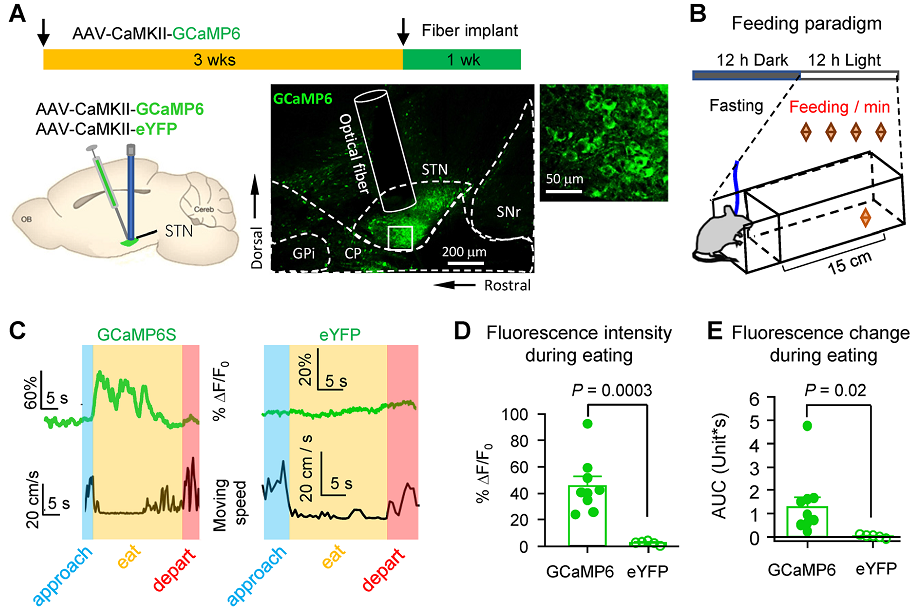AAV-hChR2 and AAV-NpHR3.0 were used for optogenetic manipulation. AAV-GCaMP6s was used for fiber photometry. (From
BrainVTA)
The viruses used from BrainVTA in this article are in the table below
|
Calcium sensors |
PT-0110 rAAV-CaMKIIa-GCaMP6s-WPRE-hGH polyA |
|
Optogenetic |
PT-0296 rAAV-CaMKIIa-hChR2(H134R)-EYFP-WPRE-hGH polyA
PT-0008 rAAV-CaMKIIa-NpHR3.0-EYFP-WPRE-hGH polyA |
Haichuan Wu, Xiang Yan, Dongliang Tang, Weixin Gu, Yiwen Luan, Haijiang Cai, Chunyi Zhou, Cheng Xiao
Pub Date: 2020-06-21,
DOI: 10.1007/s12264-020-00533-3,
Email: [email protected]
Deep brain stimulation of the subthalamic nucleus (STN) is an effective therapy for motor deficits in Parkinson’s disease (PD), but commonly causes weight gain in late-phase PD patients probably by increasing feeding motivation. It is unclear how STN neurons represent and modulate feeding behavior in different internal states. In the present study, we found that feeding caused a robust activation of STN neurons in mice (GCaMP6 signal increased by 48.4% ± 7.2%, n = 9, P = 0.0003), and the extent varied with the size, valence, and palatability of food, but not with the repetition of feeding. Interestingly, energy deprivation increased the spontaneous firing rate (8.5 ± 1.5 Hz, n = 17, versus 4.7 ± 0.7 Hz, n = 18, P = 0.03) and the depolarization-induced spikes in STN neurons, as well as enhanced the STN responses to feeding. Optogenetic experiments revealed that stimulation and inhibition of STN neurons respectively reduced (by 11% ± 6%, n = 6, P = 0.02) and enhanced (by 36% ± 15%, n = 7, P = 0.03) food intake only in the dark phase. In conclusion, our results support the hypothesis that STN neurons are activated by feeding behavior, depending on energy homeostatic status and the palatability of food, and modulation of these neurons is sufficient to regulate food intake.
 Figure 1. The activity of STN neurons is enhanced during food consumption.
Figure 1. The activity of STN neurons is enhanced during food consumption.
The study is aimed to explore the association between deep brain stimulation of the subthalamic nucleus (STN) and feeding behaviors in late-phase PD patients. The results suggested that STN neurons are not only activated by feeding, varying with the energy status of mice and the size, valence, and palatability of the food, but also regulate food intake during the active state (dark phase). This could be a physiological mechanism underlying the weight gain following STN DBS.
BrainVTA offers viral vector construction & virus packaging services for AAV, LV, RABV, PRV, HSV and VSV that help researchers explore questions about genes, neurons, circuitry structure, function of brain network, mechanism and treatment of diseases.
If you have any needs, just email us at
[email protected].
